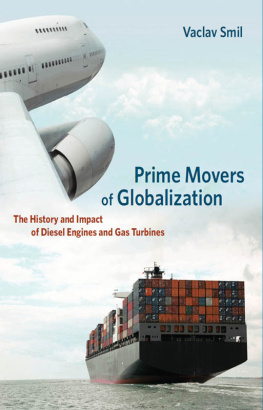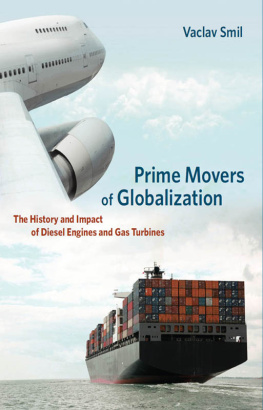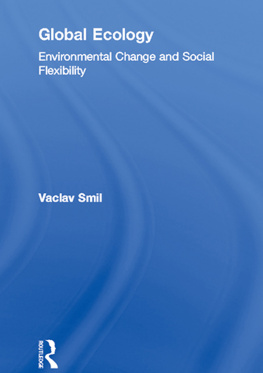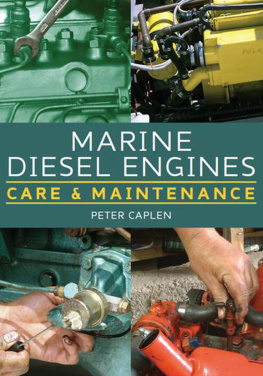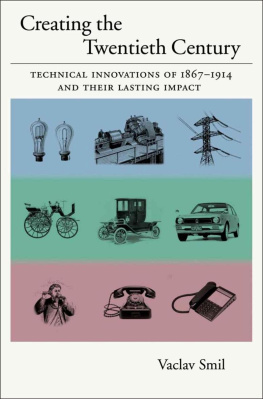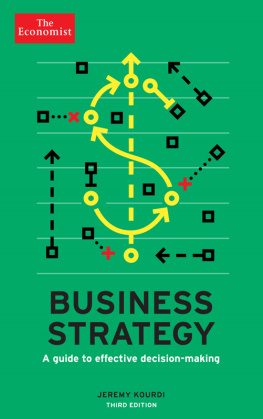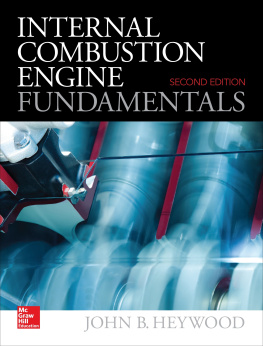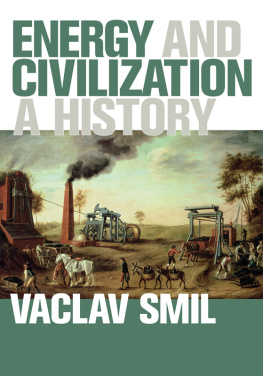
Prime Movers of Globalization

Also by Vaclav Smil
Chinas Energy
Energy in the Developing World (editor, with W. E. Knowland)
Energy Analysis in Agriculture (with P. Nachman and T. V. Long II)
Biomass Energies
The Bad Earth
CarbonNitrogenSulfur
Energy Food Environment
Energy in Chinas Modernization
General Energetics
Chinas Environmental Crisis
Global Ecology
Energy in World History
Cycles of Life
Energies
Feeding the World
Enriching the Earth
The Earths Biosphere
Energy at the Crossroads
Chinas Past Chinas Future
Creating the 20th Century
Transforming the 20th Century
Energy: A Beginners Guide
Energy in Nature and Society
Oil: A Beginners Guide
Global Catastrophes and Trends
Why America Is Not a New Rome

Two Prime Movers of Globalization
The History and Impact of Diesel Engines and Gas Turbines
Vaclav Smil
The MIT Press
Cambridge, Massachusetts
London, England
2010 Massachusetts Institute of Technology
All rights reserved. No part of this book may be reproduced in any form by any electronic or mechanical means (including photocopying, recording, or information storage and retrieval) without permission in writing from the publisher.
For information about special quantity discounts, please email .
This book was set in Sabon by Toppan Best-set Premedia Limited. Printed and bound in the United States of America.
Library of Congress Cataloging-in-Publication Data
Smil, Vaclav.
Prime movers of globalization : the history and impact of diesel engines and gas turbines / Vaclav Smil.
p. cm.
Includes bibliographical references and index.
ISBN 978-0-262-01443-4 (hardcover : alk. paper)
ISBN 978-0-262-29704-2 (e-book)
1. Diesel motorHistory. 2. Gas turbinesHistory. 3. Technology and civilization. 4. TransportationTechnological innovationsHistory. 5. Motor vehiclesMotorsHistory. 6. GlobalizationHistory. I. Title.
TJ795.S5746 2010
621.43dc22
2009049190
10 9 8 7 6 5 4 3 2 1

Contents

Prime Movers of Globalization
1

Globalization Waves and Their Prime Movers
... the new regime of the seas provoked a growing primacy of the Far West over other civilizations of the earth.... The circulation of ideas... took on a new pattern and velocity.
William H. McNeill, The Global Condition
The phenomenon of globalizationthe planet-spanning process of economic exchanges and information links, of complex flows of social and political influences, and of unprecedented environmental consequenceshas been examined from many perspectives, with results ranging from highly arguable claims to insightful observations. The search for historical precedents has led to indefensible claims (such as Jack Weatherfords 2004 conclusion that Genghis Khan was a thoroughly modern man who was committed to global commerce) and to simplistic misreadings of complex historical, social, and economic realities (such as Thomas L. Friedmans 2005 exaggerated claims of a flat world). Among the most valuable contributions have been the examinations of links between economic globalization and planetwide environmental impacts, above all the process of anthropogenic climate change that encompasses a complex realm of causes and feedbacks (Alley et al. 2007).
But one approach has been rather conspicuously missing from these examinationsa focus on those techniques that have made this remarkable process possible. How have we arrived at the point of moving among the continents billions of tons of fuels, ores, cement, fertilizers, and feed- and foodstuffs and an enormous variety of industrial goods comprising ever-changing myriads of specifications and amounting commonly to tens of thousands and in some cases (most notably cars) even millions of tons per particular product? How it has come about that we can fly from virtually any place that has an airport with a runway long enough (at least 2.5 to 3 km) to accommodate large Boeing and Airbus jetliners to any other similarly equipped place anywhere on the planet often within just sixteen and mostly within twenty-four hours?
How have these realities affected the performance of modern economies, and how have they shaped the course of modern history? How have they changed the extraction and trade of basic natural commodities, and how have they influenced the location of manufacturing and exports of finished products? What have been the major benefits and (often counterintuitive and intractable) drawbacks of this planet-scale transformation? A fundamental way of answering these questions requires first looking at the prime moversthe machines that convert naturally available (primary) energies into the mechanical power that is used to energize fleets of ships and airplanes (and also trains, trucks, and barges) and to compress the liquids and gases that are transported by pipelines, then contrasting their performance with the capabilities of their less effective predecessors, and, finally, outlining the principal consequences of these developments.
This mode of inquiry is one segment of studying historys grand sweep as a continuous (but unevenly progressing) transition to new prime moverstheir invention, introduction, perfection, diffusion, and eventual displacement by more efficient, more reliable, and more affordable alternatives (Smil 1994, 2005, 2006, 2008). The greatest reward of this approach is that it informs us about the most fundamental physical determinants of the globalization process, as the dominant prime movers clearly delimit the cost, volume, speed, and reliability of transfers and trips whose aggregate forms the web of economic and human interactions on the global scale.
Civilizations that relied primarily on muscles and a few simple mechanical devices of limited power capacities and inherently low conversion efficiencies (that is, all premodern societiesfrom the earliest kingdoms of the Middle East to the city states of Italian Renaissance and the contending powers of the early modern Europe) had a greatly circumscribed scope of possible action and a distinctly slower tempo of life than their successors, which command increasingly more efficient and more reliable high-capacity prime movers. In turn, by extending this inquiry into the multifaceted economic, social, political, and environmental impacts of these technical innovations, we can better understand their possible future development and the need and timeframes of their modifications or displacements.
Next page
